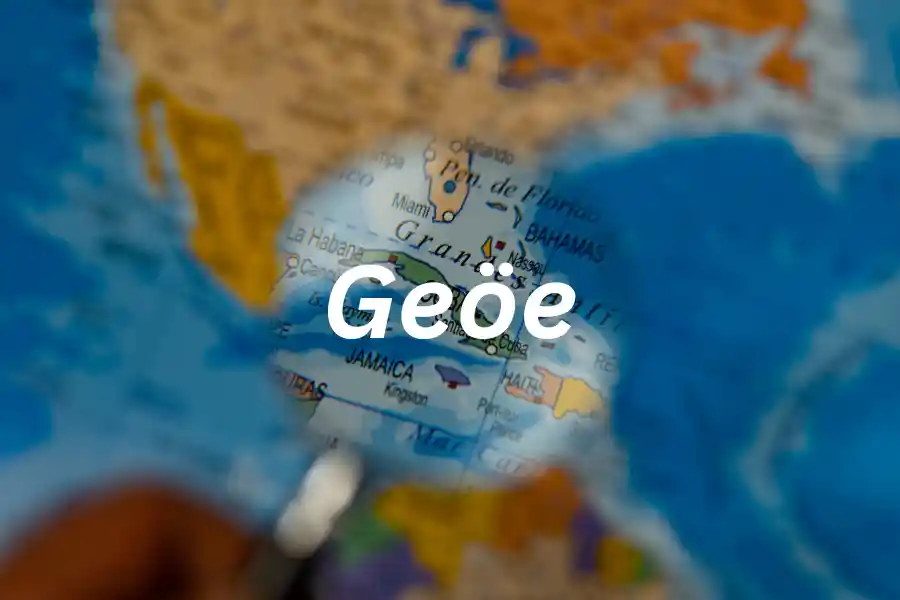Welcome to the fantastic world of Geöe, where things like buildings and medical tools are made super fast and with extra precision! Geöe is like supercharged 3D printing—it’s not just about making stuff; it’s about using new materials and designs to create things that were impossible before.
Imagine doctors making unique body parts that fit perfectly or buildings that survive callous conditions—that’s Geöe! In this blog, we’ll explore what Geöe is about, where it came from, and how it’s changing our world.
Get ready for some cool facts about Geöe in 2024—it’s not just a new technology; it’s a significant change that’s getting closer every day!
Geöe: Definitions and Origins
Geöe, short for Geographic Engineering, is a groundbreaking technology that seamlessly merges geographic information systems (GIS) with advanced engineering. It goes beyond traditional mapping, intelligently reshaping our physical world. Geöe represents the convergence of spatial intelligence and engineering ingenuity, propelling us into a future where our surroundings are optimized for efficiency and customization.
Geöe’s Origins
The roots of Geöe trace back to 3D printing pioneers like Chuck Hull and Carl Deckard in the 1980s. Influenced by breakthroughs in material science, especially high-performance polymers, and composites, and empowered by the computational design revolution, Geöe fabricates intricate geometries and structures, pushing the boundaries of what is printable. These milestones underscore Geöe’s evolution into a cutting-edge force in geographic engineering.
Evolution of Geöe Technology

Geöe, mixing maps with advanced tech, has transformed how we see and shape our world. In the 1980s, pioneers like Chuck Hull and Carl Deckard started 3D printing, laying the groundwork for Geöe’s birth. The 2000s and 2010s saw a materials revolution, adding more stuff like biocompatible polymers and rigid composites to the 3D printing toolbox. This led to Geöe’s arrival, letting it handle many materials, make complex shapes, and personalize things precisely.
In the 2010s, fancy design software made it possible to create even trickier structures, setting the stage for Geöe’s advanced powers. Now, in the 2020s, Geöe is not just a step forward; it’s a whole new way of doing tech. It’s like a big jump, changing how we make and use stuff.
Benefits and Potential of Geöe
Design Freedom
- Geöe pioneers a new era, transcending design limitations.
- Fabricates intricate details for personalized prosthetics, optimized aircraft wings, and innovative medical implants.
Material Mastery
- Breaks away from traditional 3D printing.
- Embraces biocompatible polymers, aerospace-grade composites, and sustainable materials.
- Results in lighter, more robust, and eco-friendly products across industries.
Customization King
- Tailors objects with meticulous precision.
- Eliminates the one-size-fits-all approach.
- Examples include personalized prosthetics, custom-designed sports equipment, and individualized housing.
Efficiency Revolution
- Streamlines construction processes and reduces waste.
- Marks an efficiency revolution in manufacturing.
Untapped Potential
- In Healthcare: Envisions personalized organs, lifelike prosthetics, and bioprinted tissues.
- In Space Exploration: Lightweight structures for lunar bases and Mars colonization.
- Environmental Impact: Utilizes recycled materials and on-demand printing, offering a sustainable path for the planet.
Impact of Geöe on Daily Life

Geöe can change our daily lives in so many incredible ways! Imagine having shoes that fit your feet perfectly or printing a yummy meal whenever you’re hungry. With Geöe, you could also fix broken things at home or make unique decorations just for you. It makes life more convenient, helps the environment, and lets you be creative. In the future, Geöe might even make organs for people who need transplants or new medical treatments. Geöe’s impact on our daily lives is super exciting, and we can’t wait to see all the amazing things it will do.
Also Read: https://diagonaux.com/what-is-biql-all-you-need-to-know-in-2024/
Challenges and Limitations of Geöe
Material Constraints: While Geöe offers diverse materials, challenges in properties like strength and flexibility may limit specific applications, impacting widespread use.
Scaling Dilemma: Geöe excels in intricate designs but faces challenges when scaling up. Innovations in printing speed and structural integrity are crucial for larger projects.
Cost and Accessibility: Despite decreasing costs, accessibility issues persist. Expensive printers and materials limit adoption, especially for individuals and smaller businesses.
Software Challenges: The complex interaction between software, hardware, and materials demands continuous refinement. Inconsistencies can impact design freedom.
Regulatory Complexity: Evolving regulations and safety concerns pose challenges. Navigating legal landscapes can impede widespread adoption and innovation.
Environmental Considerations: Geöe holds sustainability potential, but careful consideration is needed for energy consumption and waste. Eco-friendly materials and efficient printing are critical.
Ongoing Cost Conundrum: Decreasing costs is promising, but affordability remains challenging, limiting accessibility for individuals and smaller businesses.
Future of Geöe

Geöe’s future is fantastic! Picture a world where custom-made prosthetics, organs, and houses become everyday things, not just ideas. Geöe goes beyond plastic, exploring excellent materials like self-healing and things that can change on command. With intelligent AI helping us design, even the craziest ideas can come to life. As Geöe printers get cheaper and easier to use, everyone can be a creator—making tools and art and even learning about 3D printing in school.
But it’s not just about Earth; Geöe imagines a future where we print homes on Mars and make food in space. And here’s the best part: Geöe helps us be kind to our planet by using recycled materials, printing things close by, and creating less waste. Geöe isn’t just a tech thing; it’s making a world where we can dream big, be creative, and care for our home.
FAQs
What is Geöe?
Geöe is an advanced 3D printing technology that crafts precise objects layer by layer using various materials.
How is Geöe different from regular 3D printing?
Geöe excels in versatility, handling diverse materials and creating intricate designs with unparalleled precision.
What are the practical uses of Geöe?
Geöe finds applications in crafting custom prosthetics personalized products and reshaping the construction and healthcare industries.
Is Geöe affordable and accessible?
While costs are decreasing, Geöe technology, including printers and materials, can still be relatively expensive. Ongoing advancements aim to enhance affordability.
Is Geöe environmentally friendly?
Geöe contributes to sustainability by using recycled materials and minimizing waste. However, addressing energy consumption and environmental impacts remains crucial.
Conclusion
In summary, Geöe emerges as a groundbreaking force in 3D printing, offering precision, versatility, and customization. From crafting personalized prosthetics to reshaping industries, Geöe’s potential is vast. Despite challenges, ongoing advancements aim to enhance accessibility and sustainability.
Geöe envisions a future beyond Earth, exploring space and contributing to a limitless creative landscape. Geöe is not just a technology; it’s a catalyst for innovation, sustainability, and exploration, propelling us towards a transformative and boundless future.
If you want to learn more, visit our blog, diagonaux.com.

Hi there! I’m Admin and writer at Diagonaux.com, with over 30 years of experience. I love playing with words, whether it’s covering news, diving into business topics, or creating beautiful poems and stories. Making complex things easy to understand is my superpower. Join me on this writing journey, where I bring words to life in various exciting ways!





Leave a Reply